1. A case for challenge
Nothing is more important in arbitration than the impartiality and independence of arbitrators.[i] Parties hand over their fundamental right to have their dispute heard to one or more individuals in the hope that they will get it right. Arbitrators enjoy extensive power to decide on the merits and, apart from some limited circumstances, nothing can be done if they get it wrong.[ii] Faith in the fact that these individuals will decide the case impartially and independently is paramount. Due to the arbitrator’s dual quality as a party creation and final adjudicator, there is nothing quite equivalent in other systems of dispute resolution.
A dreaded circumstance is where, unbeknownst to one side, an arbitrator (or several) have a pre-disposition toward one side’s arguments (whether consciously or not), which is not based on the underlying case but prior relationships or knowledge. Proving actual bias is very difficult. The test is one of apparent bias that is assessed objectively on the basis of all the circumstances.[iii]
Disclosure is key: we must avoid the unknown unknowns. That is the focus of the IBA Guidelines on Conflicts of Interest (the “IBA Guidelines“)[iv] and that was the focus of the recent UK Supreme Court decision in Halliburton v Chubb.[v] Lord Hodge and Lady Arden acknowledged the public interest in upholding the integrity of arbitration as a dispute resolution mechanism by ensuring proper disclosure.[vi]
This article stands a practical guide for parties who wish to challenge one or more members of an arbitral tribunal (or defend a challenge). It looks at three sets of arbitral bodies: the LCIA, the ICC and ICSID.[vii]
2. The mechanics
Applicable rules
The process for bringing a challenge before arbitral bodies is fairly straightforward and, now, relatively standardised.[viii] A typical challenge requires for it to be made in writing by reference to specific grounds and accompanied by substantiating evidence. Once the challenge is made, the arbitration proceedings are suspended pending the decision on the challenge. Other parties, the arbitrator(s) subject to the challenge and any co-arbitrators are permitted to comment. If the challenge is rejected the arbitrator remains in situ and the arbitration resumes. If the challenge is accepted, one or more arbitrators are removed and another appointed in his or her place. The appointment of the replacement arbitrator(s) usually follows the same process as the one for the original appointment.
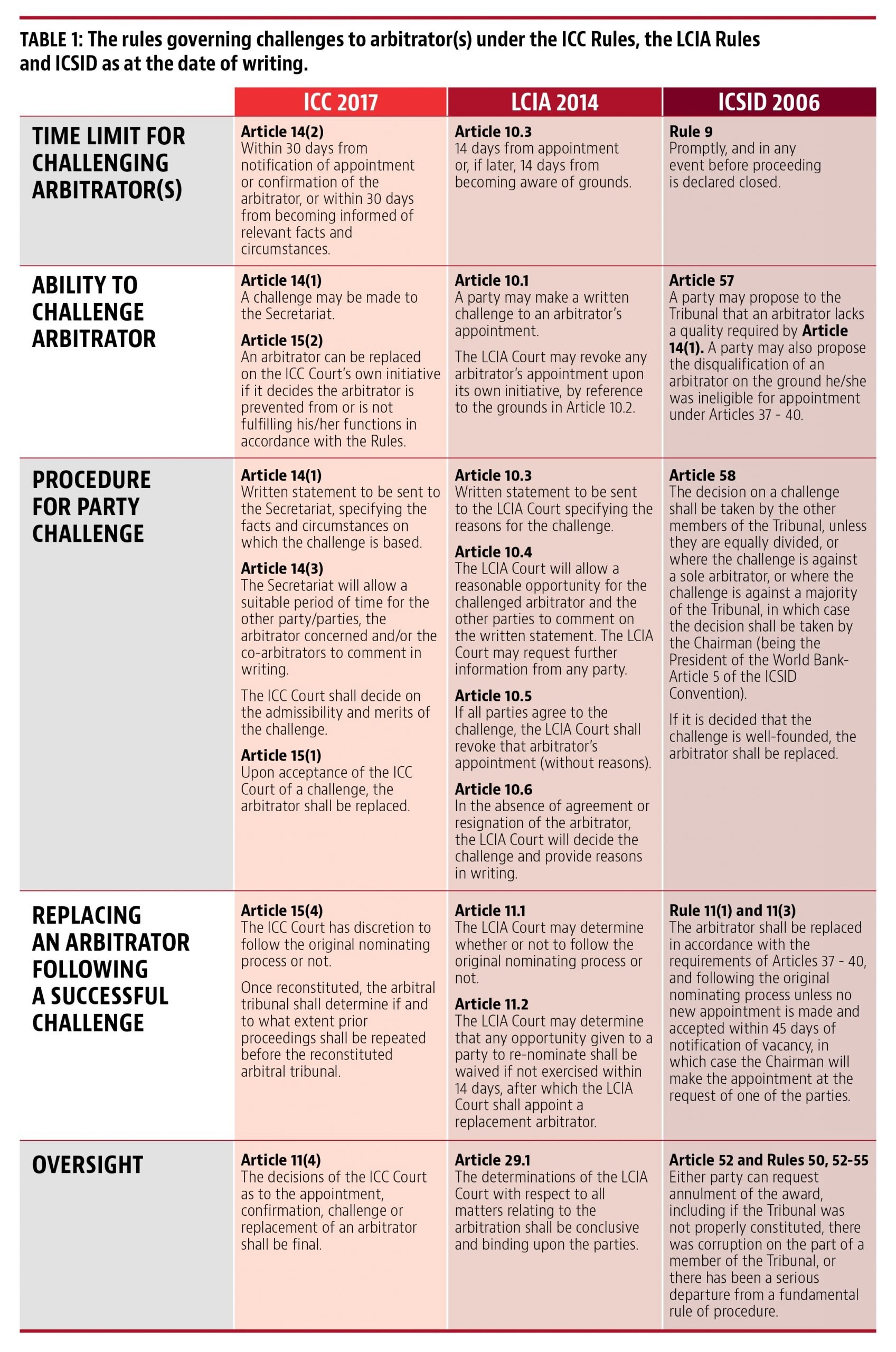
Applicable law
In international commercial arbitration, the applicable law is likely to be the lex arbitri as supplemented, to the extent permitted, by the parties’ chosen arbitration rules and often the IBA Guidelines.[ix] Although the parties will be guided mostly by the content of the arbitration rules (and temporally any challenge may first need to be brought under these), the starting point for any challenge must be the law of the seat. The law of the seat and the courts of the seat would usually have the final say on matters of arbitrators’ challenge; an imperative to preserve the integrity of the arbitration process.[x]
Where the seat of arbitration is in London, section 24 of the English Arbitration Act 1996 permits a party to apply to court to seek the removal of an arbitrator on the basis of a lack of impartiality, relevant qualifications, capacity or inappropriate conduct of the proceedings, once all of the remedies under the parties’ chosen arbitration rules have been exhausted.[xi] During the court’s review, the arbitration proceedings may continue. When considering such an application, the court will apply the test of whether a fair-minded and informed observer, having considered the facts, would consider that there was a real possibility that the tribunal was biased.[xii] The outcome of this process is likely to be the end of the road for any challenge.[xiii]
In an ICSID arbitration, and apart from the different terminology that is used for a similar set of processes, the key difference is that the lex arbitri is the ICSID Convention. It is an integrated system established under international law with ICSID as its own safeguard to the integrity of the arbitration process. The test that is applied to determine the challenge is an objective one, based on how a reasonable third party would evaluate the evidence (strikingly similar to the one set by the English courts) and if a challenge is refused, a party may still have the option to seek an annulment of the award if it can show that the Tribunal was not properly constituted, there was corruption on the part of a member of the Tribunal, or there was a serious departure from a fundamental rule of procedure.[xiv]
The grounds
Each of the three arbitral bodies allows for a challenge where there is doubt over an arbitrator’s impartiality or independence. Each seeks to achieve confidence in the arbitration process. Under the ICC Rules the lack of independence or impartiality must be “alleged”, under the LCIA Rules there must be “justifiable doubts”, and under ICSID there must be a “manifest lack” of the qualities required of arbitrators. A plain reading suggests that there are different standards, with ICSID having the strictest threshold to be met by the parties, but the underlying test (although not expressly set out) is similar; that of an objective third party with the relevant knowledge.[xv] Each institution also requires specific reasons to be articulated, which often emerge from the background of the appointment of the arbitrator, or the arbitrators’ conduct during proceedings. These are frequently based on the IBA Guidelines discussed below.
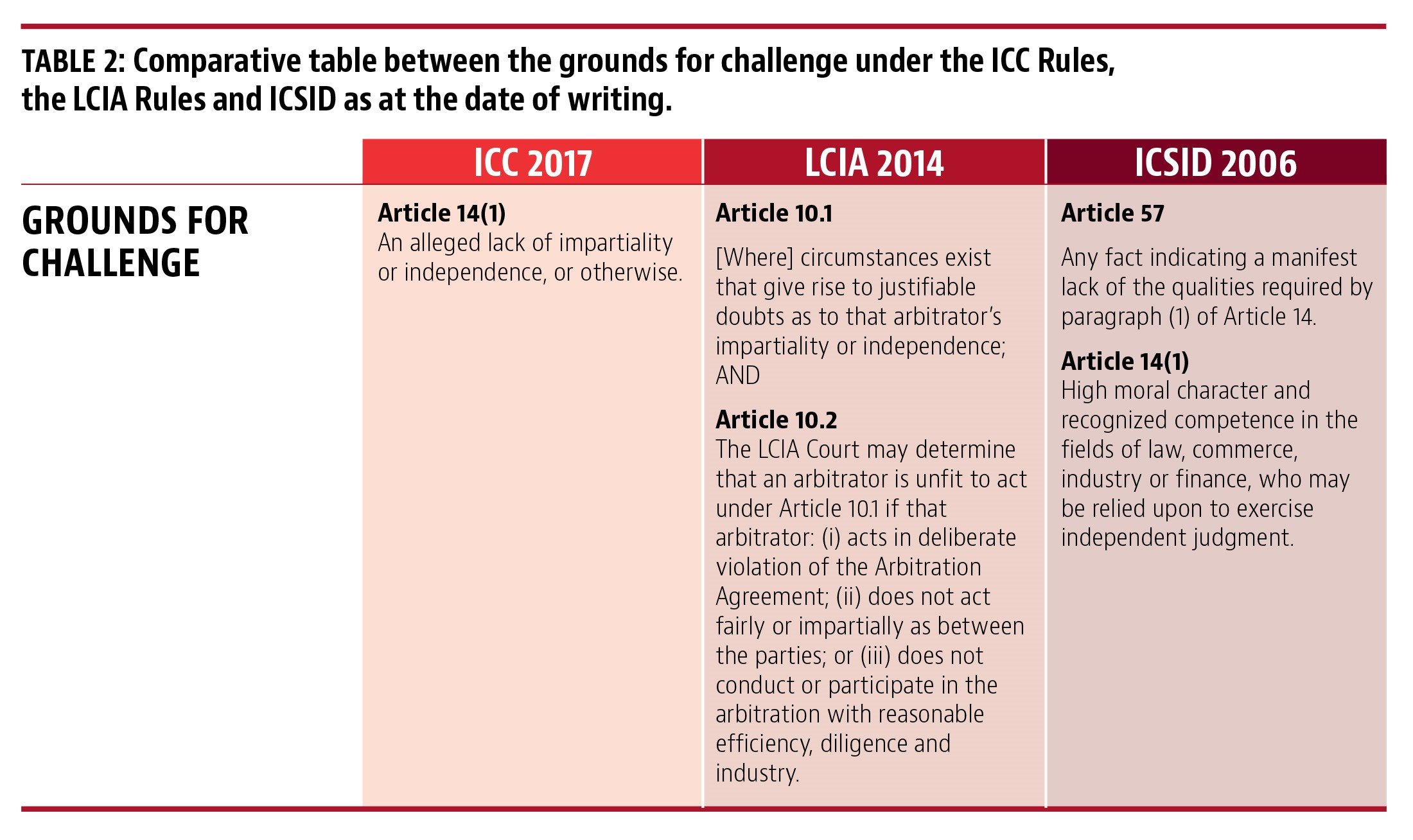
3. Importance of disclosure
The IBA Guidelines
The IBA Guidelines do not form part of the lex arbitri and are seldom expressly chosen by the parties in their arbitration agreement. And yet, they are often (if not always) cited and relied on when a challenge is brought. First issued in 2004, they were last updated in 2015, and in their current introductory wording state that they have “gained wide acceptance within the international arbitration community“. The IBA Guidelines are global in nature and have the goal of consistent application across common and civil law jurisdictions, commercial and investor state arbitration, in all industry sectors and whether or not the arbitrators are legally qualified persons. They seek to achieve uniformity across a disparate landscape.
Part I of the IBA Guidelines detail seven “General Standards”, which set out the fundamental principles of an arbitrator being, and being seen to be, impartial and independent and discussing when a disclosure should be made. Disclosure, it is said, rests on the principle that the parties have an interest in being fully informed. Explanatory notes accompany each standard, setting out the motivation for the standard, or adding further detail to promote consistent interpretation and application.[xvi]
Part II, described as a “practical application” of the seven standards, explains the purpose of the categories and provides non-exhaustive examples of scenarios that are: (i) acceptable and unlikely to require disclosure (Green); (ii) potentially acceptable, but could objectively give rise to a concern over impartiality and independence, and therefore may require disclosure (Orange); (iii) serious circumstances that must be disclosed, but parties may permit the person to be or remain an arbitrator, so long as they are fully informed of the relevant detail (Red Waivable); and (iv) serious circumstances, deriving from the principle that no person can be his or her own judge, that cannot be ignored or waived, with the consequence that the arbitrator in question should not act (Red Non-Waivable).[xvii]
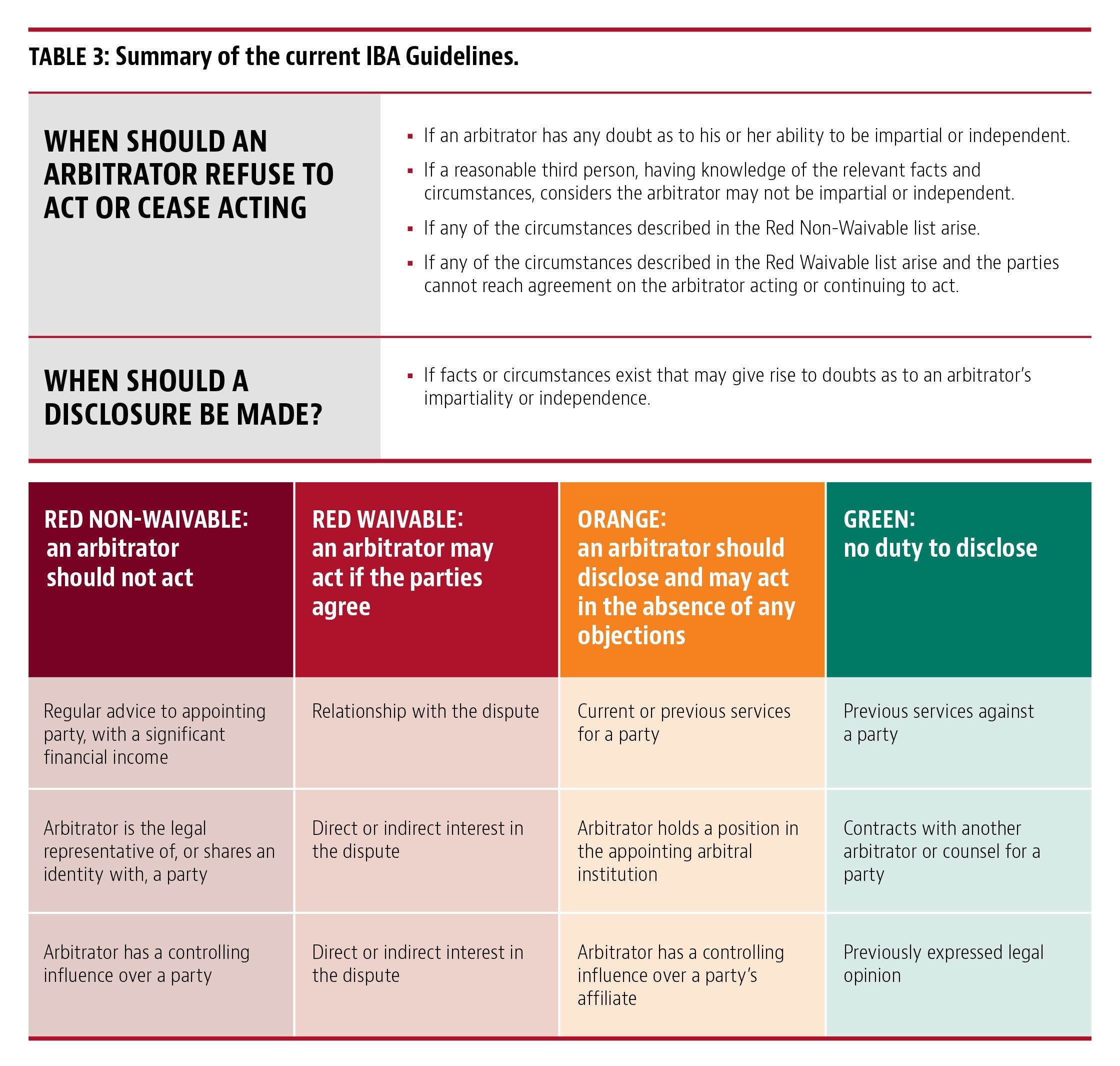
The premise of the Red Non-Waivable category, illustrates a weakness of the IBA Guidelines. The list purports to remove control from the parties, by seeking to mandate that any scenario falling within the Red Non-Waivable list cannot be approved of by the parties such that the arbitrator remains on the tribunal. The recent English case of W Limited v M SDN BHD[xviii]illustrates the inherent problem with this approach. Whilst the conflict situation fell squarely within the Red Non-Waivable list,[xix] the English Court concluded that there was no apparent bias due to the particular facts of the case. The arbitrator had been unaware of the affiliate company being linked to his firm after it was purchased, and his firm’s conflict checker did not pick up the relationship either. Some degree of flexibility may be needed, and on a straight reading of the IBA Guidelines this is not provided for.[xx]
The Halliburton Case
The IBA Guidelines have recently come under strict scrutiny. The facts of the Halliburton case[xxi] are simple. The Halliburton Company (Halliburton) provided services to BP in the Gulf of Mexico. Transocean Ltd also provided services to BP, including overlapping services to those provided by Halliburton. Halliburton entered into a liability policy with Chubb Bermuda Insurance Ltd (Chubb), which also insured Transocean Ltd. In 2010, there was an explosion and fire on an oil rig in the Gulf of Mexico, the “Deepwater Horizon” oil spill. Many claims were brought against BP, Halliburton and Transocean. BP also claimed against Halliburton and Transocean.
Following a trial in the US, Halliburton concluded a settlement on damages and claimed a proportion of this settlement under its insurance policy. Chubb refused to pay. Arbitration was commenced. The Bermuda Form arbitration is a specialist form of arbitration, not governed by one of the major arbitral institutions. Both parties selected their own arbitrator, but the parties were unable to agree on the Chairman. This resulted in an application to the High Court following which Chubb’s first-choice Mr Rokison was selected. In 2016, Halliburton discovered that, after his appointment and without Halliburton’s knowledge, Mr Rokison had accepted appointments as an arbitrator in two other references, both of which arose out of the same Deepwater Horizon incident: (i) Transocean’s claim against Chubb; and (ii) a nomination by another insurer to arbitrate another claim by Transocean arising out of the same incident.
The decision centres on disclosure and apparent bias. Arbitrators have a duty of disclosure, and the Supreme Court confirmed that this is a legal duty arising out of the statutory duties of impartiality under section 33 of the Arbitration Act 1996. The failure to disclose at the relevant time may lead to sanctions. It will also be a factor when the court considers whether or not the challenged arbitrator lacked impartiality. However, the relevant time to ask the question of whether the fair-minded and informed observer would conclude there is a real possibility of bias is at the time of the hearing to remove the arbitrator.
In cases where disclosure is called for, a failure to disclose may give rise to the appearance of bias – but it is only a factor to take into account, it is not, in and of itself, determinative. The court held that in the circumstances of this case, Mr Rokison’s failure to disclose was a breach of his legal duty. However, by the time of the removal hearing, circumstances meant that the objective observer would not infer a real possibility of unconscious bias. Mr Rokison had provided an explanation of his failure to disclose, English case law had been unclear as to whether disclosure was a legal duty and Mr Rokison’s conduct provided no basis for interring subconscious ill-will in respect of the ferocity of the challenge made against him.
4. The data
In the context of the case load statistics we have reviewed, formal challenges against arbitrators are limited and only succeed in rare cases.
In the years 2014 to 2019, ICC and LCIA caseloads have increased steadily and the proportion of cases where a challenge against one or more arbitrators was made has remained consistently low. Far fewer challenges are brought under the LCIA Rules, with an average 1.81% of cases compared to the ICC Rules with an average 5.72%[xxii] – more than triple. A possible reason for this is the short period in which the challenge must be brought under the LCIA Rules (14 days). In spite of this, the success rate of these challenges are not drastically different: challenges under the LCIA Rules have an average success rate of 8.57% and challenges under the ICC Rules have an average success rate of 11.31%.[xxiii]
With a predictably lower caseload, the data is very different for challenges brought under ICSID. Parties are more comfortable bringing challenges in ICSID proceedings, but these hardly ever succeed. However, this greater number of challenges could be indicative of a greater level of tactical challenges for the purpose of delay.[xxiv] On average, for the period of 2014 to 2019, 14.28% of ICSID cases involved a challenge to one or more arbitrators. Of these, an average of only 5.13% were successful (three in the six years under consideration). There are also likely to be overlapping cases[xxv] and one or two particularly discontent parties (involving Venezuela) having brought at least 8 of the total 39 challenges.[xxvi]
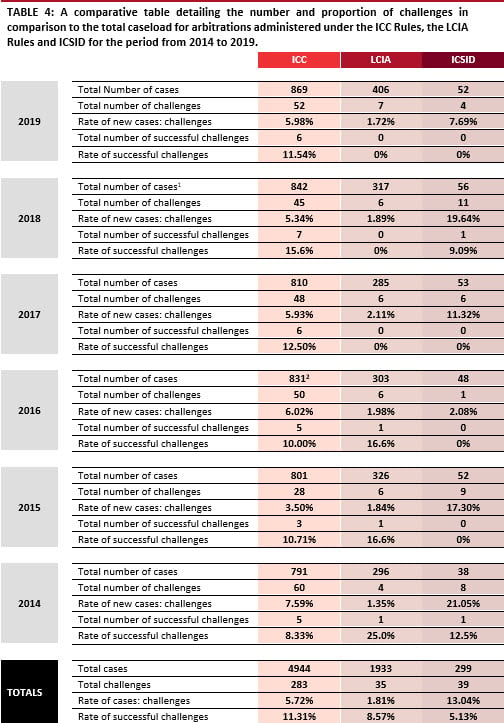
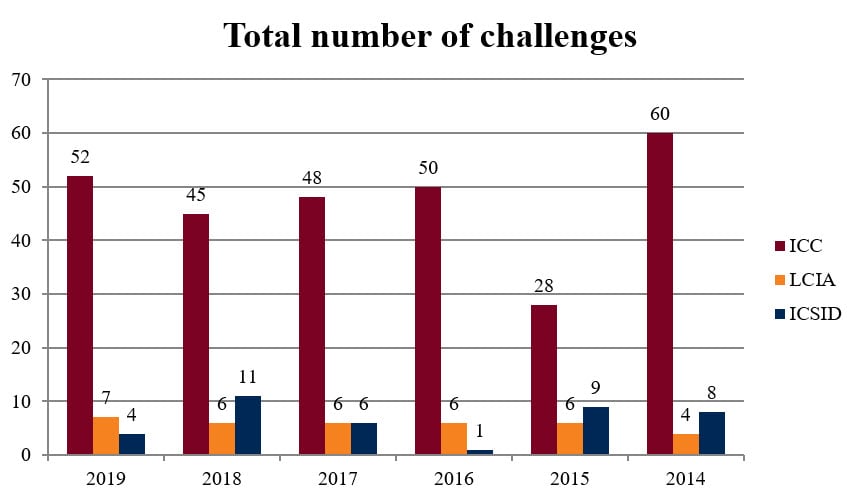
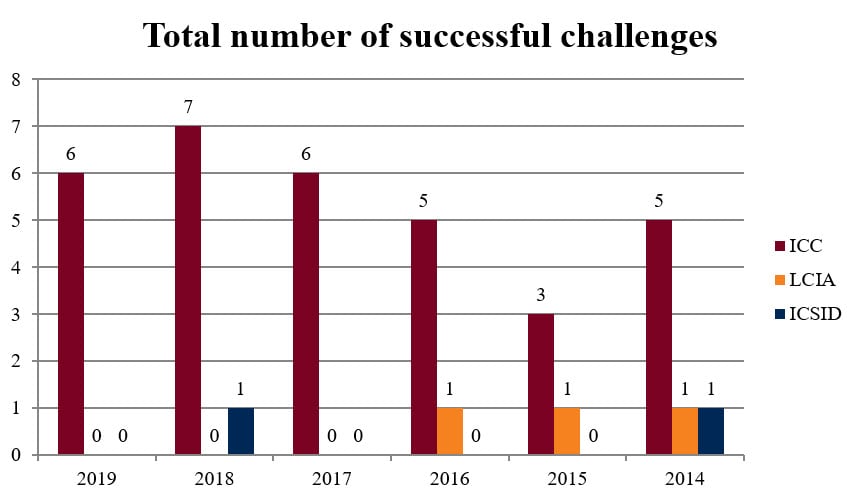
5. A case for change?
The integrity of the arbitral process is of fundamental importance to its continued success and to the trust placed in it by parties who choose to resolve their dispute by way of arbitration. This was squarely recognised and confirmed by the Supreme Court in its Halliburton decision, and their confirmation of an express legal duty of disclosure under English law can be seen as a pro-arbitration stance, favouring the promotion of transparency, within the confines of the varying bounds of privacy and confidentiality that apply to different arbitrations.
The recognition by the Supreme Court of the differing customs and practice of divergent fields of arbitration, in particular where the pool of experienced arbitrators is much narrower than in general commercial arbitration, is – in our view – both pragmatic and helpful. This is an area where one size does not fit all. Arbitrators must consider what degree of confidentiality applies to the relevant arbitral process they have been nominated to adjudicate over, whether the parties have consented to any necessary disclosure (be that express or inferred), and then whether such disclosure is necessary – taking into account the objective test under English common law, or the subjective standard incorporated into some institutional rules[xxvii].
The data described above demonstrates that challenges are fairly rare, and even fewer are successful. The IBA Guidelines are at pains to emphasise that disclosure does not go hand in hand with apparent bias, and this has been reaffirmed by the Supreme Court’s decision. It does not follow that because a disclosure is made, an arbitrator cannot or should not act. Of course, this fact does not of itself guard against the risk of strategic challenges. In any event, maintaining trust and confidence in arbitration as a balanced and effective method of dispute resolution is likely to take precedence over the possibility of an increase in arbitrator challenges.
If greater disclosure does emerge following the confirmation of an express legal duty, it will be interesting to see if an increase in challenges results. That is not the expectation of the court, and certainly its decision does not pave the way for borderline challenges to be pursued. The corollary to the perceived threat of an increase in unnecessary challenges may be for institutions to sharpen their teeth into not just providing for, but enforcing, concrete consequences. Arbitrators also often have the power to award costs against a party bringing a frivolous challenge. Whilst rarely done, it remains a potentially powerful deterrent.
The original version was first published on 1 February 2020 in Edition 36 of the Young Arbitration Review.
The authors would like to thank Bradley Mycock for his invaluable assistance in reviewing and analysing the cases, compiling the key statistics and more generally for his help in writing this article during his time in the Dispute Resolution Department at Baker McKenzie in London.
[i] See, for example: paragraphs 2 – 4 of the introductory text to the IBA Guidelines (cited below at endnote (v)); section 33(1)(a) of the English Arbitration Act 1996, which states that the tribunal shall “act fairly and impartially as between the parties“, this mirrors the provisions of Article 18 of the Model Law. Further, Gary Born calls impartiality a “defining characteristic” of arbitration (paragraph 8 of Chapter 1 of his 2015 book International Arbitration: Law and Practice 2nd edn.), and the enforcement of impartiality and independence of arbitrators “vital” (Chapter 7, Ibid); and Mustill and Boyd’s seminal text refers to the requirement of the impartiality of the tribunal as being “so obvious as to require no elaboration” (page 44, sub-paragraph (v), Commercial Arbitration, 2nd edn, 1989).
[ii] The UNCITRAL Model Law and the New York Convention do not allow a review on the merits (assuming that the dispute is arbitrable in scope by reference to that country’s law) except for issues of public policy, although some systems allow a review of the law in limited circumstances, e.g., section 69 of the English Arbitration Act 1996 allows an appeal to the court on a question of law arising out of an award (this can, however, be contracted out of by the parties); and Article 52 of the ICSID Convention, which permits an application for annulment, an exceptional recourse to “safeguard against the violation of fundamental legal principles relating to the process“.
[iii] See endnote xii below.
[iv] IBA Guidelines on Conflicts of Interest in International Arbitration, adopted by resolution of the IBA Council on 23 October 2014, and updated on 10 August 2015. Available online at: https://www.ibanet.org/Publications/publications_IBA_guides_and_free_materials.aspx (last accessed on 23 December 2019).
[v] Halliburton Company (Appellant) v Chubb Bermuda Insurance Ltd (formerly known as Ace Bermuda Insurance Ltd) (Respondent) [2020] UKSC 48
[vi] Ibid, paras. 63, 80, 81, 103. See also Lady Arden at para. 160 on interrelationship between the duty of impartiality and the duty of disclosure.
[vii] Although different in nature and scope, these have been chosen due to their popularity, the availability of data around challenges and because, together, they cover a wide range of disputes and both international commercial and investment arbitration.
[viii] See, for example, paragraph 50 of Chapter 7 of G. Born’s 2015 book International Arbitration: Law and Practice (Op Cit), where he confirms, after discussing the UNCITRAL procedure, that the same basic structure of a challenge is followed by other institutional rules.
[ix] This is consistent with paragraph 6 of the introductory wording to the IBA Guidelines (Op Cit), where it is acknowledged that the IBA Guidelines do not override any applicable national law, but it is hoped that they will find broad acceptance in the international arbitration community.
[x] Any other approach would arguably allow the final say on this critical matter to persons or organisms that may have an interest in the outcome of the decision. This is the reason for the English Arbitration Act providing for section 24 regarding the removal of arbitrators as a mandatory provision that cannot be derogated by the parties. Before turning to the courts, the parties are required to have exhausted any challenges they can bring under their chosen rules. The final say, however, rests with the courts. This is reflected also in Article 13(3) of the Model Law and parties cannot contract out of this provision for the interlocutory judicial consideration of challenges.
[xi] See section 24(1) and (2) of the English Arbitration Act 1996, and the cases referred to immediately below.
[xii] The test for bias was confirmed by the House of Lords (as it then was) in: Porter v Magill [2001] 1UKHL 67, namely: whether “a fair-minded and informed observer, having considered the facts, would conclude that there was a real possibility that the tribunal was biased.” This is, in effect, a test for apparent bias, as opposed to real or actual bias. The Court of Appel in Halliburton Company v Chubb Bermuda Insurance Ltd [2018] EWCA Civ 817 confirmed that this is an objective test that should not be confused with the approach of the person who brought the complaint (paragraph 40 of the judgment). Furthermore, Mr Justice Hamblen held that whether there is actual or apparent bias is irrelevant, if apparent bias is found that is sufficient to lead to substantial injustice, actual bias does not also need to be proved: Cofely Limited v Anthony Bingham [2016] EWHC 240 (Comm) at paragraph 116.
[xiii] Though parties should also bear in mind the possibility of a challenge to an arbitrator being used as a ground to resist enforcement of or set aside any subsequent award (subject to any relevant time limits).
[xiv] See for example, Article 52 of the ICSID Convention and Arbitration Rules 50 and 52-55; and Article V of the New York Convention on the Recognition and Enforcement of Foreign Arbitral Awards (New York, 10 June 1958).
[xv] See, for example, paragraph 28 of the decision of Electrabel S.A. v. Republic of Hungary (ICSID Case No. ARB/07/19), where the arbitrators stated that “The Claimant accepts that our decision “must be made on the basis of an objective review of the established facts.“
[xvi] See paragraph 3 of the Introduction to the IBA Guidelines.
[xvii] See Explanation to General Standard 2 at sub-paragraph (d).
[xviii] [2016] EWHC 422 (Comm).
[xix] Paragraph 1.4 of the Non-Waivable Red List.
[xx] See also Lady Arden at paras. 167 to 169 in the Halliburton case (Op Cit vii).
[xxi] Op Cit vii, paras. 7 to 27.
[xxii] The 2016 statistics include 135 related small claim cases arising from a collective dispute. The numbers here exclude these.
[xxiii] According to the LCIA Annual Casework Report 2 cases remain pending and have not yet been decided.LCIA statistics available online here: https://www.lcia.org/News/annual-casework-report-2019-the-lcia-records-its-highestnumbe.aspx#:~:text=The%20LCIA%20had%20an%20outstanding,the%20highest%20number%20ever%20received. (last accessed on 2 December 2020).
[xxiv] See, for example, an article by Y. Kryvoi of BIICL entitled “ICSID Arbitration Reform: Mapping Concerns of Users and How to Address Them” available online at: https://ssrn.com/abstract=3280782 (last accessed on 27 January 2020).
[xxv] Víctor Pey Casado v Chile, Fábrica de Vidrios Los Andes v Venezuela, and ConocoPhillips v Venezuela. Full references: Víctor Pey Casado and President Allende Foundation v Republic of Chile (ICSID Case No. ARB/98/2); Fábrica de Vidrios Los Andes, C.A. and Owens-Illinois de Venezuela, C.A. v Bolivarian Republic of Venezuela (ICSID Case No. ARB/12/21); ConocoPhillips Petrozuata B.V., ConocoPhillips Hamaca B.V. and ConocoPhillips Gulf of Paria B.V. v Bolivarian Republic of Venezuela (ICSID Case No. ARB/07/30). These three cases alone account for 10 of the 39 challenged cases.
[xxvi] ICSID decisions on disqualification, available online at: https://icsid.worldbank.org/cases/content/tables-of-decisions/disqualification (last accessed on 2 December 2020).
[xxvii] For instance, an agreement under ICC Rules 2017 or LCIA Rules 2014 give contractual effect to IBA Guidelines, which contain a subjective standard for disclosure, namely the facts and circumstances that may “in the eyes of the parties” give rise to doubts about the arbitrator’s independence and impartiality.




